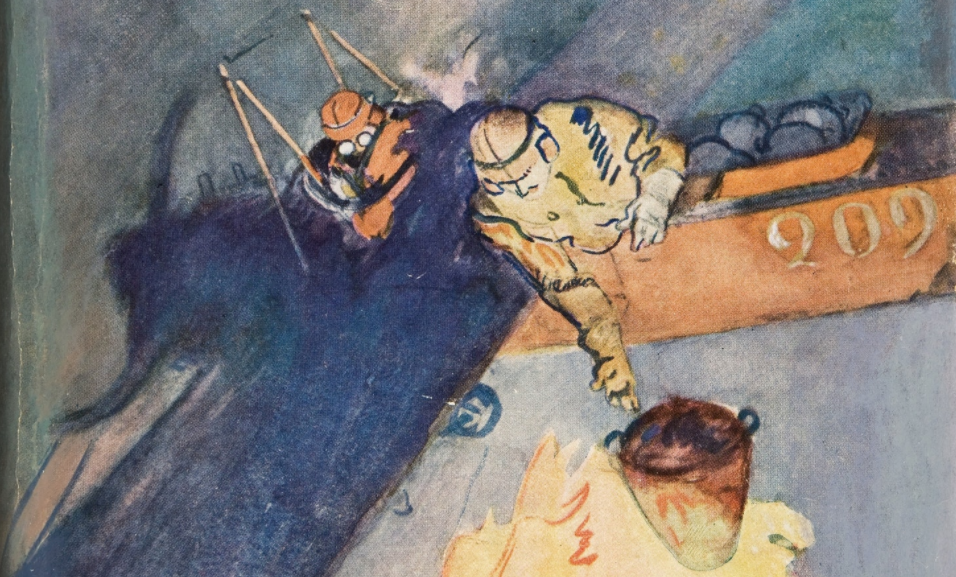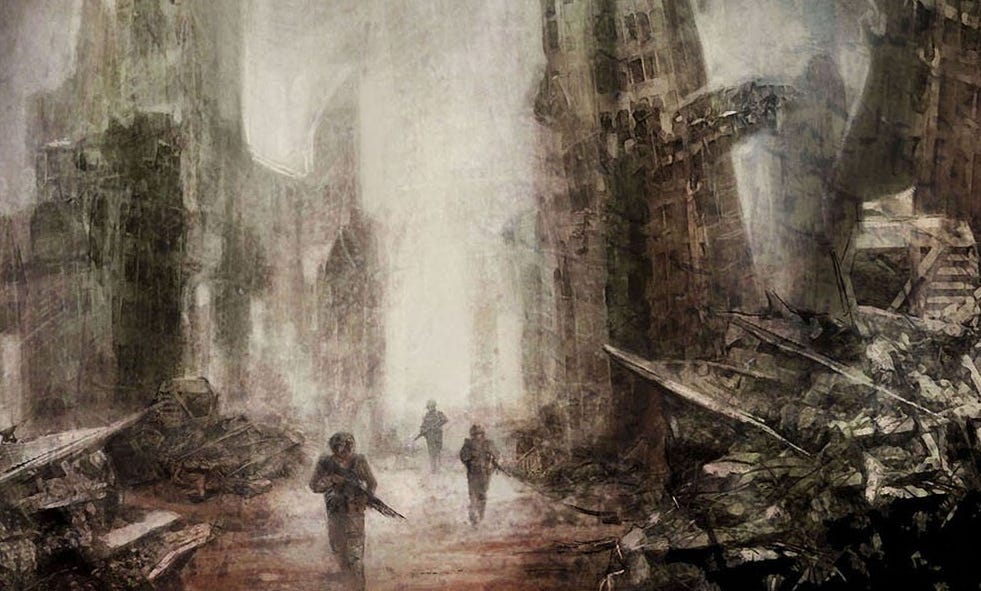Mushroom Clouds on the Future Horizon
Science fiction was born in the fires of Hiroshima and Nagasaki

“Hiroshima now lay to the west on the right side of my airplane. I looked down and saw a roiling, dirty brown cloud spreading out horizontally over the city. Out of it was emerging a vertical cloud that looked like it contained every color of the rainbow, and more. The colors were vivid — hard to describe — some I had never seen before. I saw a series of fires breaking through the quickly spreading smoke that was covering the city. The vertical cloud was rising rapidly. In what seemed an instant, it had reached 30,000 feet, and it continued rising to over 45,000 feet. As it gained altitude, a huge white mushroom shape formed over the top.”
So wrote Charles W. Sweeney, in his memoir, War’s End: An Eyewitness Account of America’s Last Atomic Mission. 75 years ago today, was piloting the The Great Artiste, a B-29 Superfortress tasked as the blast measurement instrumentation aircraft during a moment never seen before in the history of warfare: the first atomic bomb used against an enemy. Sweeney would later go on to command the mission that dropped a second, more powerful atomic bomb on Nagasaki just three days later.
Rarely in history are there singular moments like those two atomic attacks, with a distinct before and after. The world of after was something long imagined only in the pages of science fiction pulp magazines and in the minds of their rosters of eccentric authors and readers. Art in all of its forms has been an examination of the present moment, but with the dawn of the atomic era, science fiction came into its own.

Throughout his career as a writer, H.G. Wells imagined all the ways in which people would go to war. He was born at a time that the balance of power in the world was changing rapidly: the industrial revolution had ushered in new technologies and means to undermine the traditional structures of power around a rapidly globalizing world. Wells was well-schooled in science and wrote extensively about the advances of the day before turning to the advances of tomorrow, penning science fiction classics like The Time Machine, The Island of Doctor Moreau, The First Men In the Moon, The Invisible Man, The War of the Worlds, and others.
Wells recognized the relationship between humanity, technology, and warfare, and as Sarah Cole writes in Inventing Tomorrow: H.G. Wells and the Twentieth Century, “throughout his life and in many different genres, Wells explored war’s logic in relation to humanity’s precarious condition.”
Most readers are familiar with Wells’ The War of the Worlds (or its many adaptations) and the technological future of combat that he envisions as an advanced an alien force from Mars lands on Earth and commences a devastating attack. Wells was interested in the near-future of warfare as well. Just five years after the Wright Brothers successfully demonstrated their aircraft at Kitty Hawk in 1903, he published The War in the Air, a serialized story about both the coming of World War I and the potential devastation that airpower could bring to warfare.
On the cusp of World War I, Wells published The World Set Free, imagining a devastating weapon unleashed on the battlefield.
The bomb flashed blinding scarlet in mid-air, and fell, a descending column of blaze eddying spirally in the midst of a whirlwind. Both the aeroplanes were tossed like shuttlecocks, hurled high and sideways and the steersman, with gleaming eyes and set teeth, fought in great banking curves for a balance. The gaunt man clung tight with hand and knees; his nostrils dilated, his teeth biting his lips. He was firmly strapped....
When he could look down again it was like looking down upon the crater of a small volcano. In the open garden before the Imperial castle a shuddering star of evil splendour spurted and poured up smoke and flame towards them like an accusation. They were too high to distinguish people clearly, or mark the bomb’s effect upon the building until suddenly the facade tottered and crumbled before the flare as sugar dissolves in water. The man stared for a moment, showed all his long teeth, and then staggered into the cramped standing position his straps permitted, hoisted out and bit another bomb, and sent it down after its fellow.
Atomic bombs would reappear in another of Wells’ works: 1933’s The Shape of Things to Come, which imagined the distant future of warfare, with countries attacking one another with fleets of airplanes and bombing enemy cities. It’s a fictional reality that would come true in just a decade in the Second World War.
Importantly, Wells focuses not just on the technologic dynamics of war, but on how the weapons of the future will effect everyone. In her book, Cole writes that “for Wells, there was something absolutely basic about how the civilian becomes representative, since he was constantly advancing two lines of inquiry that came together in the form of the nonsoldier caught up in the war: the modern thrust of industry, global connectedness, and in his view, political and moral inadequacy in relation to the new forces plunging world conflict into ever greater extremes, and his interest in the ordinary person.”
Science fiction isn’t a reliable forecast into the future, but authors who pay attention to new technologies and how they are used often have insights that line up neatly with how they turn out. Wells was certainly one such author, and his works were a chilling warning to readers about what the future of warfare might look like.

Wells wasn’t the only author paying attention to the future of warfare. Over the course of the 1920s and 1930s, a number of science fiction pulp magazines sprang up in the United States with titles like Air Wonder Stories, which looked at the rapidly-evolving technology of airplanes and the adventures that it could bring. In his introduction to the first issue, Hugo Gernsback wrote that “Aviation is no longer a new thought in literature,” and that “Air Wonder Stories will present SOLELY flying stories of the future, strictly along scientific—mechanical— technical lines, full of adventure, exploration and achievement.”
(Interestingly, one of the stories in that debut issue — “The Bloodless War”, by David H. Keller — imagines not just the threat that air power posed to nations, but also imagined drone warfare.)
Others would follow. In one oft-told tale, Astounding Science Fiction editor John W. Campbell had been obsessed with the idea of atomic power, ever since he had learned that Columbia University possessed a cubic foot of Uranium and had been following the news about atomic research. With the onset of World War II, Campbell had worked contribute to the war in his own way, publishing stories about future war, and trying to help the US Government out with technical documentation.
When he rejected a story by author Cleve Cartmill in 1943, he suggested that the writer tackle another idea that he’d come up with: the development of an atomic bomb and its use. Extrapolating from existing publicly-known research, Cartmill’s story “Deadline” appeared in Astounding in 1944.
The story detailed enough about the enrichment process for a nuclear bomb that FBI agents began looking into Campbell to see if someone from the Manhattan Project had leaked some information to him. The meeting stoked Campbell’s ego, and as Alec Nevala-Lee wrote in Astounding: John W. Campbell, Isaac Asimov, Robert A. Heinlein, L.Ron Hubbard and the Golden Age of Science Fiction, gave Campbell tact confirmation that the government was working on something and reaffirmed what science fiction could do: predict the future.
The incident demonstrated that science fiction’s framework of meshing factual information with speculation could be useful — and indeed, some investigators worried about the scientists at Los Alamos thinking too deeply about the ethical ramifications of the weapons they were working on.
World War II and its destruction weighed heavily on the authors writing in the genre. Isaac Asimov went to Campbell in August 1941 with an idea for how a group of people would try and rebuild society after the widespread collapse of a galactic civilization — Foundation. Writing in Arthur C. Clarke: The Authorized Biography, Neil McAleer notes the Clarke, who had envisioned the communications satellite, saw the prospect of atomic warfare as the polar opposite: “the atomic bomb was the technology of disintegration.” He soon went on to write Twilight, “a powerful story about nuclear war,” writes McAleer, “filled with haunting images the last of which is Shakespeare’s gravestone and its carved epitaph sinking beneath the deadly glow of the river Avon.”
If science fiction was good at spinning out the possibilities of technology, it was equally good at looking at the consequences of those technologies. One could invent a fictional bomb and its uses, but what comes next is the ruins and destruction that they bring.
Science fiction rose alongside the US economy in a post-war boom, pushed along by an educated workforce and explosion of science and technology, which provided both the means and inspiration for authors. But while the US emerged from World War II largely unscathed and prosperous, the mushroom clouds of Hiroshima and Nagasaki loomed large.
Just four years after the US dropped its own bombs, the Soviet Union successfully tested its own in 1949, kicking off the Cold War that would send school children hiding under desks, and the rise of the military industrial complex. The arms race between the two countries would lead to new technological heights, kicking off the space race that ultimately brought the US to the Moon, as well as fantastical new advances in materials sciences, aviation, communications, and entertainment. While science fiction had imagined the possibilities of traveling through space, the preparation of conflict helped make it a reality.
The prospect of nuclear war alarmed some authors and represented endless new possibilities. War could now be conducted at the push of a button, a misinterpreted reading on a screen, or by accident. Robert Heinlein, who had served in the US Navy, worried about the possibility of being caught in a blast radius if Colorado was hit by an enemy missile, and wrote Starship Troopers, while other authors looked at what the conflict would bring, either on a technological level, or on a sociological one. Walter M. Miller Jr. explored the aftermath of a devastating nuclear war in the US in his 1959 novel A Canticle for Leibowitz, while Ursula K. Le Guin’s The Dispossessed explores two dynamically-opposed societies.

Fans and scholars often identify Mary Shelley’s Frankenstein as the origin point for what we now call science fiction. Followed by authors like Jules Verne, Edgar Allan Poe, and H.G. Wells, the genre became a way for writers and readers to imagine what the future might hold as science and technology played a greater role in their world.
With Hiroshima and Nagasaki, science fiction came of age. The bombings ushered in a brand new world in which technology and modern life were inseparable, impacting everyone from the items in their kitchen to the satellites flying overhead, and to the prospect that they might be wiped out by a Soviet missile at any moment. It helped steer the genre towards one of reflection. Bombings of those two Japanese cities were proof-positive that science fiction was not just a genre that tackled the technological promise of a better future, but also the potential destruction brought by the advances of new technologies.
Those mushroom clouds hang just over the future horizon, and remain in the background of most science fiction. They’re the roots of the post-apocalyptic wasteland, of futuristic soldiers waging war on distant planets, and behind every possibility that the future we want might be horribly wrong. It’s something that’s persisted for the last 75 years, and hopefully, they’ll remain in our minds as a cautionary tale as we tackle the next 75.